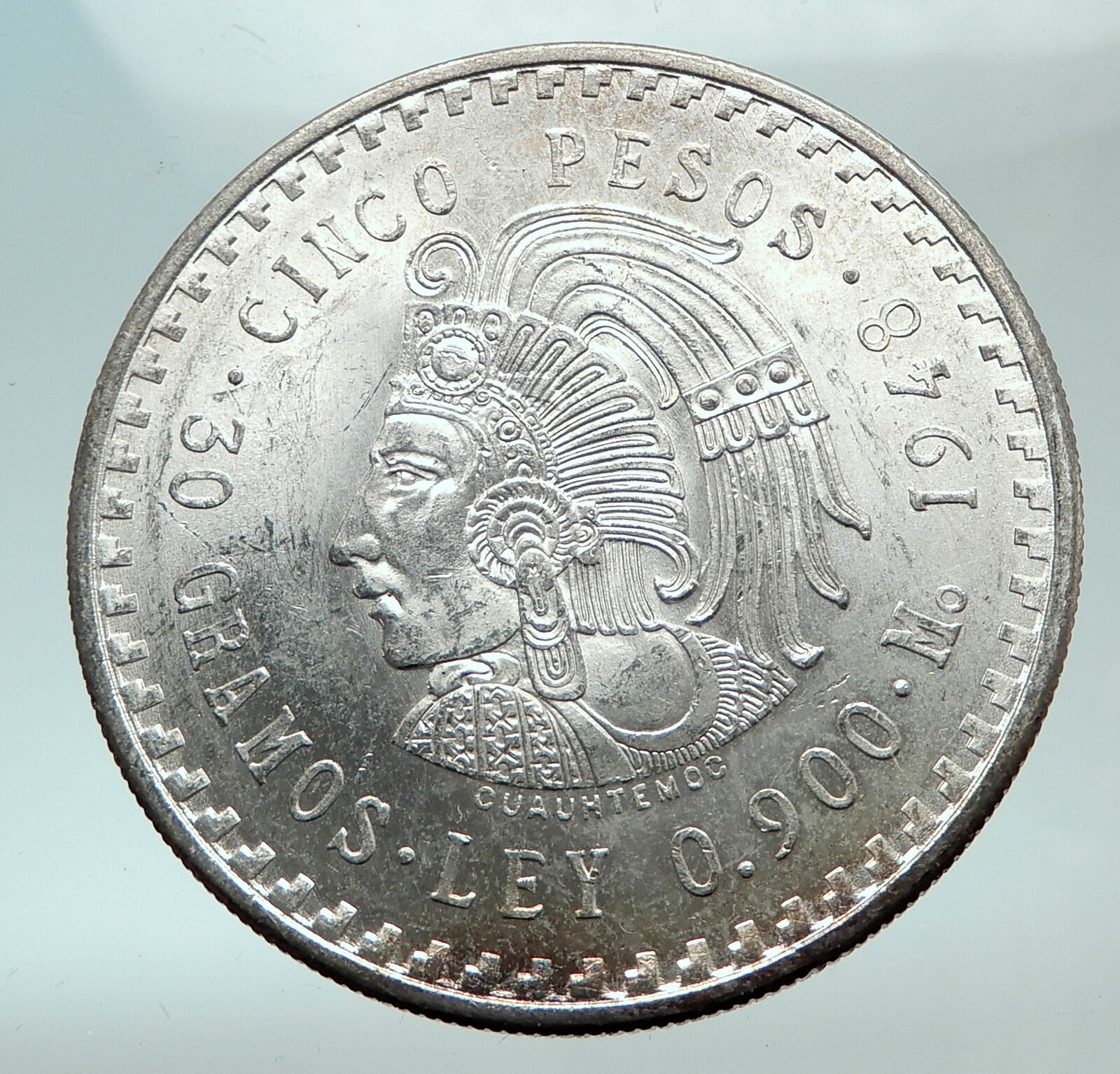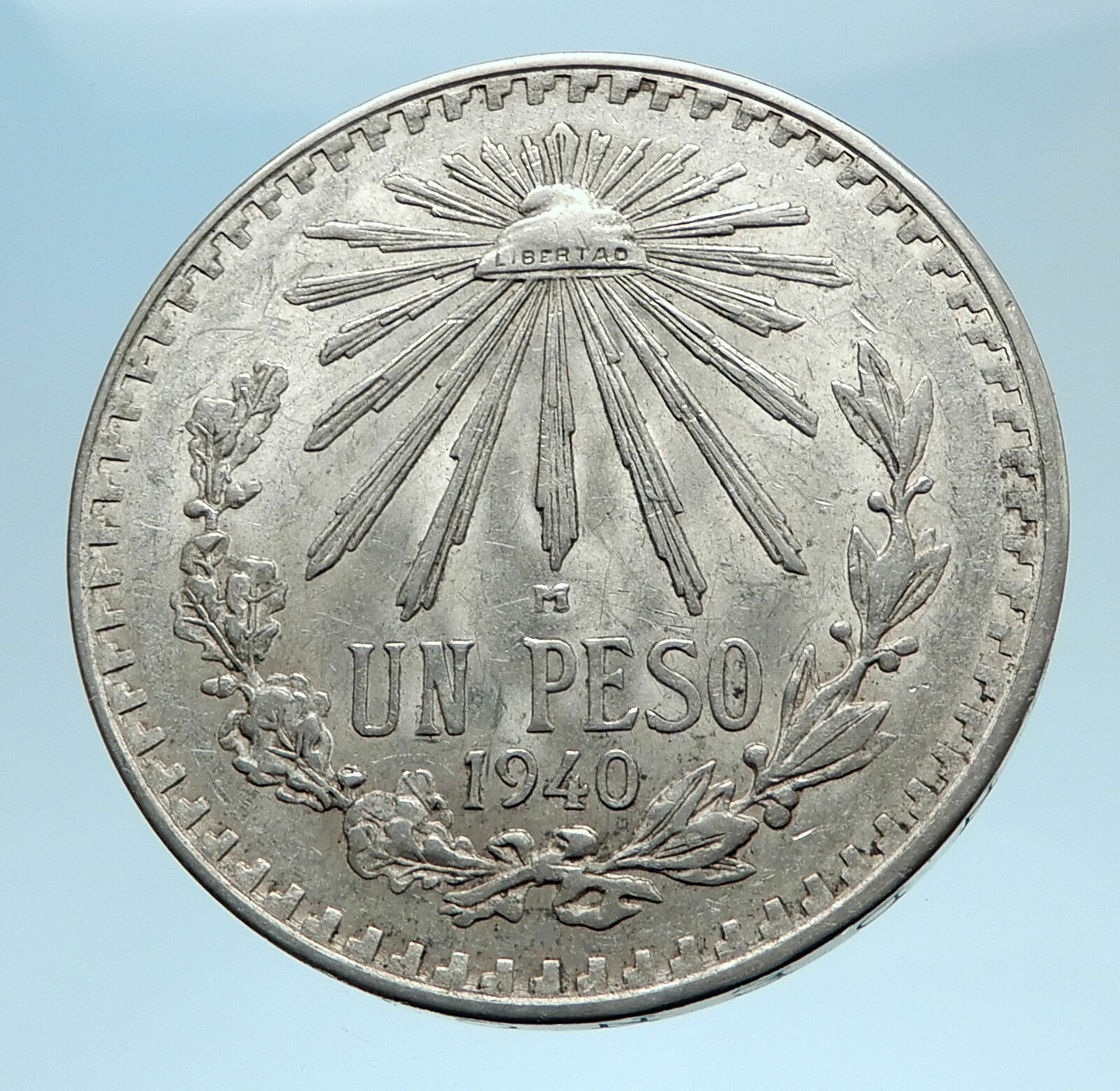|
Mexico
1953 Silver 5 Pesos 40mm (27.70 grams) 0.720 Silver (0.6431 oz. ASW)
Reference: KM# 467 (1951-54*)
HIDALGO, Head of Hidalgo left within wreath.
ESTADOS UNIDOS MEXICANOS PESO 27 7/9 G LEY 0.720 CINCO PESOS Mo, The coat-of-arms of Mexico
Edge Lettering:
COMERCIO – AGRICULTURA – INDUSTRIA
You are bidding on the exact item pictured, provided with a Certificate of Authenticity and Lifetime Guarantee of Authenticity.
 Miguel Gregorio Antonio Ignacio Hidalgo y Costilla y Gallaga Mondarte Villaseñor ( 8 May 1753 – 30 July 1811), more commonly known as Miguel Hidalgo y Costilla or simply Miguel Hidalgo, was aMexican priest and a leader of the Mexican War of Independence . Miguel Gregorio Antonio Ignacio Hidalgo y Costilla y Gallaga Mondarte Villaseñor ( 8 May 1753 – 30 July 1811), more commonly known as Miguel Hidalgo y Costilla or simply Miguel Hidalgo, was aMexican priest and a leader of the Mexican War of Independence .
In 1810 Hidalgo led a group of indigenous and mestizo peasants in a revolt against the dominant peninsulares under the banner of the Virgin of Guadalupe. After clashes with the criollos and Mexican townspeople the group disbanded. Hidalgo was captured on 21 March 1811, and executed on 30 July.
Hidalgo’s rebellion was the beginning of what would become the Mexican War of Independence. Although he was unsuccessful in his original aim, Hidalgo’s efforts were followed by those of José María Morelos and Agustín de Iturbide who brought down the colonial governments of Spain in Mexico. Hidalgo is considered the Father of the Nation of Mexico.
 Mexico, officially the United Mexican States, is a federal republic in North America. It is bordered on the north by the United States; on the south and west by the Pacific Ocean; on the southeast by Guatemala, Belize, Mexico, officially the United Mexican States, is a federal republic in North America. It is bordered on the north by the United States; on the south and west by the Pacific Ocean; on the southeast by Guatemala, Belize,  and the Caribbean Sea; and on the east by the Gulf of Mexico. Covering almost two million square kilometres (over 760,000 sq mi), Mexico is the fifth largest country in the Americas by total area and the 13th largest independent nation in the world. With an estimated population of over 113 million, it is the eleventh most populous and the most populous Spanish-speaking country in the world and the second most populous country in Latin America. Mexico is a federation comprising thirty-one states and a Federal District, its capital and largest city. and the Caribbean Sea; and on the east by the Gulf of Mexico. Covering almost two million square kilometres (over 760,000 sq mi), Mexico is the fifth largest country in the Americas by total area and the 13th largest independent nation in the world. With an estimated population of over 113 million, it is the eleventh most populous and the most populous Spanish-speaking country in the world and the second most populous country in Latin America. Mexico is a federation comprising thirty-one states and a Federal District, its capital and largest city.
In pre-Columbian Mexico many cultures matured into advanced civilizations such as the Olmec, the Toltec, the Teotihuacan, the Zapotec, the Maya and the Aztec before first contact with Europeans. In 1521, the Spanish Empire conquered and colonized the territory from its base in Mexico-Tenochtitlan, which was administered as the Viceroyalty of New Spain. This territory would eventually become Mexico following recognition of the colony’s independence in 1821. The post-independence period was characterized by economic instability, the Mexican-American War that led to the territorial cession to the United States, the Pastry War, the Franco-Mexican War, a civil war, two empires and a domestic dictatorship. The latter led to the Mexican Revolution in 1910, which culminated with the promulgation of the 1917 Constitution and the emergence of the country’s current political system. In March 1938, through the Mexican oil expropriation private U.S. and Anglo-Dutch oil companies were nationalized to create the state-owned Pemex oil company.
 Mexico has one of the world’s largest economies, it is the tenth largest oil producer in the world, the largest silver producer in the world and is considered both a regional power and middle power. In addition, Mexico was the first Latin American member of the Organisation for Economic Co-operation and Development OECD (since 1994), and considered an upper-middle income country by the World Bank. Mexico is considered a newly industrialized country and an emerging power. It has the fifteenth largest nominal GDP and the tenth largest GDP by purchasing power parity. The economy is strongly linked to those of its North American Free Trade Agreement (NAFTA) partners, especially the United States. Mexico ranks sixth in the world and first in the Americas by number of UNESCO World Heritage Sites with 32, and in 2010 was the tenth most visited country in the world with 22.5 million international arrivals per year. According to Goldman Sachs, by 2050 Mexico is expected to become the world’s fifth largest economy. PricewaterhouseCoopers (PwC) estimated in January 2013 that by 2050 Mexico could be the world’s seventh largest economy. Mexico has membership in prominent institutions such as the UN, the WTO, the G20 and the Uniting for Consensus. Mexico has one of the world’s largest economies, it is the tenth largest oil producer in the world, the largest silver producer in the world and is considered both a regional power and middle power. In addition, Mexico was the first Latin American member of the Organisation for Economic Co-operation and Development OECD (since 1994), and considered an upper-middle income country by the World Bank. Mexico is considered a newly industrialized country and an emerging power. It has the fifteenth largest nominal GDP and the tenth largest GDP by purchasing power parity. The economy is strongly linked to those of its North American Free Trade Agreement (NAFTA) partners, especially the United States. Mexico ranks sixth in the world and first in the Americas by number of UNESCO World Heritage Sites with 32, and in 2010 was the tenth most visited country in the world with 22.5 million international arrivals per year. According to Goldman Sachs, by 2050 Mexico is expected to become the world’s fifth largest economy. PricewaterhouseCoopers (PwC) estimated in January 2013 that by 2050 Mexico could be the world’s seventh largest economy. Mexico has membership in prominent institutions such as the UN, the WTO, the G20 and the Uniting for Consensus.
|





 Miguel Gregorio Antonio Ignacio Hidalgo y Costilla y Gallaga Mondarte Villaseñor ( 8 May 1753 – 30 July 1811), more commonly known as Miguel Hidalgo y Costilla or simply Miguel Hidalgo, was aMexican priest and a leader of the Mexican War of Independence .
Miguel Gregorio Antonio Ignacio Hidalgo y Costilla y Gallaga Mondarte Villaseñor ( 8 May 1753 – 30 July 1811), more commonly known as Miguel Hidalgo y Costilla or simply Miguel Hidalgo, was aMexican priest and a leader of the Mexican War of Independence . Mexico, officially the United Mexican States, is a federal republic in North America. It is bordered on the north by the United States; on the south and west by the Pacific Ocean; on the southeast by Guatemala, Belize,
Mexico, officially the United Mexican States, is a federal republic in North America. It is bordered on the north by the United States; on the south and west by the Pacific Ocean; on the southeast by Guatemala, Belize,  and the Caribbean Sea; and on the east by the Gulf of Mexico. Covering almost two million square kilometres (over 760,000 sq mi), Mexico is the fifth largest country in the Americas by total area and the 13th largest independent nation in the world. With an estimated population of over 113 million, it is the eleventh most populous and the most populous Spanish-speaking country in the world and the second most populous country in Latin America. Mexico is a federation comprising thirty-one states and a Federal District, its capital and largest city.
and the Caribbean Sea; and on the east by the Gulf of Mexico. Covering almost two million square kilometres (over 760,000 sq mi), Mexico is the fifth largest country in the Americas by total area and the 13th largest independent nation in the world. With an estimated population of over 113 million, it is the eleventh most populous and the most populous Spanish-speaking country in the world and the second most populous country in Latin America. Mexico is a federation comprising thirty-one states and a Federal District, its capital and largest city. Mexico has one of the world’s largest economies, it is the tenth largest oil producer in the world, the largest silver producer in the world and is considered both a regional power and middle power. In addition, Mexico was the first Latin American member of the Organisation for Economic Co-operation and Development OECD (since 1994), and considered an upper-middle income country by the World Bank. Mexico is considered a newly industrialized country and an emerging power. It has the fifteenth largest nominal GDP and the tenth largest GDP by purchasing power parity. The economy is strongly linked to those of its North American Free Trade Agreement (NAFTA) partners, especially the United States. Mexico ranks sixth in the world and first in the Americas by number of UNESCO World Heritage Sites with 32, and in 2010 was the tenth most visited country in the world with 22.5 million international arrivals per year. According to Goldman Sachs, by 2050 Mexico is expected to become the world’s fifth largest economy. PricewaterhouseCoopers (PwC) estimated in January 2013 that by 2050 Mexico could be the world’s seventh largest economy. Mexico has membership in prominent institutions such as the UN, the WTO, the G20 and the Uniting for Consensus.
Mexico has one of the world’s largest economies, it is the tenth largest oil producer in the world, the largest silver producer in the world and is considered both a regional power and middle power. In addition, Mexico was the first Latin American member of the Organisation for Economic Co-operation and Development OECD (since 1994), and considered an upper-middle income country by the World Bank. Mexico is considered a newly industrialized country and an emerging power. It has the fifteenth largest nominal GDP and the tenth largest GDP by purchasing power parity. The economy is strongly linked to those of its North American Free Trade Agreement (NAFTA) partners, especially the United States. Mexico ranks sixth in the world and first in the Americas by number of UNESCO World Heritage Sites with 32, and in 2010 was the tenth most visited country in the world with 22.5 million international arrivals per year. According to Goldman Sachs, by 2050 Mexico is expected to become the world’s fifth largest economy. PricewaterhouseCoopers (PwC) estimated in January 2013 that by 2050 Mexico could be the world’s seventh largest economy. Mexico has membership in prominent institutions such as the UN, the WTO, the G20 and the Uniting for Consensus.




